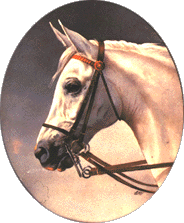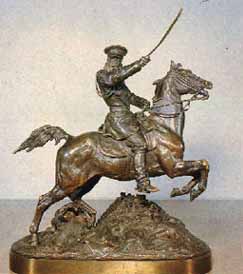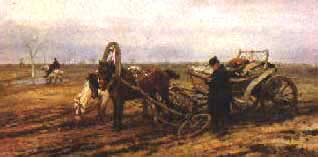
The State Science-Art Museum of Horse-breeding
"My darling friend, let us enjoy swift horse riding..!" - the poet's words involuntarily occur to visitors who are going round the Exhibition halls. It is no mere chance that this Exhibition has been arranged on the arts fund of the State Science-Art Museum of Horse-breeding. A number of exhibits it contains and a wealth of colour attract the visitor's attention and rouse everyone's interest.

An unknown Russian painter
A.G. Orlov-Chesmensky
in the sledge drawn by bars |
The horse - a wonderful creaton of Nature - has been in the focus of painters' attention from time immemorial. Pictures of horses drawn on rock by unknown artists and dating back to the Stone Age have, fortunately, reached present day time. Art devoted to animal world is known to be flourishing in Ancient Egypt, Assyria, Greece and Rome. Sculptors adorned palaces and temples with mounted army battles and hunting scenes. Painters drew the similar subjects on earthen wares, graphic artists engraved them on things made of gold and silver. The greatest painters of the Middle Ages and the Renaissance depicted horses in pictures and on engravings, erected magnificent equestrain monuments. Leonardo da Vinci is first to have written a whole treatise dealing with the horse's anatomy and movement. His book was richly illustrated with sketches and drawings of his own, resulting from his long-time observation of the horse.
Painting, sculpture and graphic arts dedicated to depicting horses reached the acme of perfection at the end of the XVIIIth and the beginning of the XIXth centuries when the best horse-breeds were raised and hippodrome races were in fashion. Side by side with genre and battle paintings which reflected the generalized image of the horse, animalists began to create "portraits" of most famous ridinghorses and trotters, achieving utmost true-to-life likeness.

Lansere E.A.
M.D. Ckobelev on the horse |
Russian painters contributed much to the successful development of this kind of art. What is there so strange in that? In 1912 there had been no other country all over the world horse live-stock capita (over 35 million) and the variety of breeds were greater than in Russia.
To collect the best samples of the "equestrian genre" and "horse portraits" was the life-work of Yakov Ivanovich Butovich, a young horse-breeder, who at the beginning of the present century got carried away with the idea. Acting regardless of the expenses he bought up pictures, drawings, pieces of sculpture and ordered canvases of his best trotters to be painted. By 1917 there had been collected a real museum located in the manor of Butovich in Prilepy (the Tulskaya Region) and named by the owner "The horse-breeding gallery". After the revolution Y.I. Butovich did not leave Prilepy and was appointed director of his stud-farm and gallery, both having been nationalized by the new power. In 1928 his richest collection - about 1200 exhibits - was conveyed to the capital where it helped to lay foundation of the State Science-Art Museum of Horse-breeding attacted to the Moscow hippodrome and opened on January 23rd, 1929. As to Y.I. Butovich, a sad fate overtook him as that of millions of his countrymen. He was arrested and imprisoned for a short period. After being released from prison he was prohibited to live in Moscow and other big towns. Having settled in Vyazma Butovich went on working at cataloguing and systematizing his collection. His manuscript has been retained and is a most valuable handbook for the Museum experts. Later on Butovich removed to the town of Shchigry (the Kurskaja Region) where he died in extreme poverty either in 1937 or 1938, the exact year of his death being unknown.

Kovalevsky P.O.
The axis was broken |
In 1940 the Museum was transferred to possession of the Timiryazev Agricultural Academy in Moscow and became integral part of the Horse-breeding Chair. The Museum is intended to help with training highly-qualified horse-breeder. During the latest decades the Museum's fund was more than doubled in quantity, and at present has at its disposal over 3000 pictures, graphic works, drawings, pieces of sculpture and other items of applied art. The biggest photo-collection (over 50000 negatives), excessively rich thematic collections of stamps, postal cards, envelopes, badges, various souvenirs which help to restore the history and reflect the contemporary state of home horse-breeding add to the significance of the Museum and the exposotion of equestrian painting.
The overwhelming majority of displayed exhibits are original works by wellknown artists, chiefly Russian masters of the brush and the chisel. There are also pictures by the greatest painters who have won a wide fame and world recognition. Paintings by Serov, Vrubel, Polenov, Plastov, drawings of Surikov and Vereshchagin kept in the Museum are obviously of great interest. The basic part of the Exhibition is, however, made up by works of those painters to whom the horse was the subject of their permanent creative and artistic consideration. In the Museum one can enjoy canvases by battle and animalist artists - B.P. and A.B. Villevalde, P.N. Gruzinsky, P.O. Kovalevsky, A.P. Orlovsky, P.P. Sokolov, P.F. Frents, P.K. Klodt, E.A. Lansere, N.I. Liberikh, as well as artists of the Soviet time - M.I. Avilov, T.G. Gaponenko, A.N. Glukharev, M.V. Grekov, P.D. Pokarzhevsky, G.K. Savitsky, N.S.Samokish, E.N. Gilyarov, A.I. Posyado, Skorobogatov and many others.

Adam E.The thorough-bred riding
stallion Kvo-Vadis |
The Museum fund is especially rich in works by N.E. Sverchkov ( 1817-1898) who devoted all his artistic activities to portraying horses. More than 210 oil-paintings and sketches, 150 water-colours and drawings, 10 drawing-albums of Sverchkov were collected by the founder of the Museum and his followers. A whole "portrait gallery of pedigree steeds" created by Sverchkov during half a century time the Orlovsky trotters in particular, is of great value for those who show interest in history of Russian horse-breeding. In addition you can admire genre scenes of various strata of Russian society depicting the life of ordinary peasants, coachmen and also the familly life of the Emperor's relatives - and in all his pictures the horse is in the focus of the artist's attention. Dashing troikas, thorough-bred skippers, worn-out toiling horses drawn in carts or working hard in the field are the subjects of the painter's creative and artistic activities. "The silent toilers" and "Favourites of the fate" are couple pictures, symbolizing different, unequal destinies of the horses.
Sverchkov's canvases have much in common with works of sculpture created by his junior contemporary E.A. Lansere (1848-1886). The sculptures of Lansere are distinguished fot their exceptional artistic beaty and true-to-life mastership. About 30 creatons by the prominent sculptor - equestrian groups of Donsky and Zaporozhsky kosacks, nomadic Kirghiz and Kasakh people, Caucasian mountaineers, hunters with hounds and hunting birds, statuettes of various horse breeds - adorn the Museum halls and introduce a great variety of old Russia's horses.
The rich fund of the Museum permits to organize annually several expositions of paintings, water-colours, graphic works not only at home but also abroad. Lovers of both fine arts and horses have lately enjoyed them in Moscow, Saint-Petersburg, Dresden, Helsinki, Paris.
D. Gurevich.
[RUSSIAN VERSION]
Address of museum: 7, Timiryazevskaya str.
Tel.: 976-10-03
|


